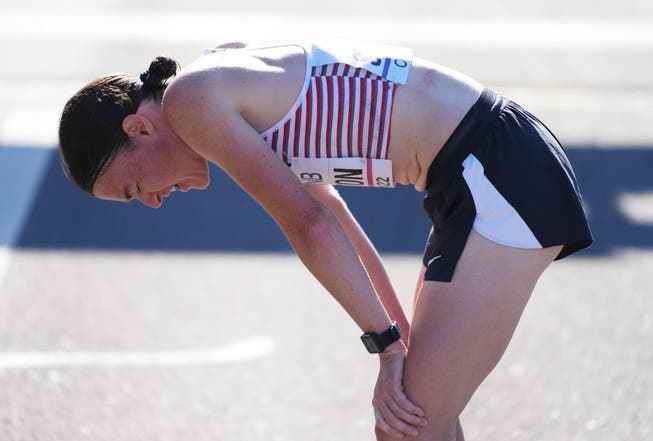Autumn is the big marathon season. These running events take place from Berlin to New York. The offer may tempt spontaneous people to participate – which can have negative consequences that should not be underestimated.
Playing with your limits in the short term by running a marathon is a phenomenon of our time (here the New York City Marathon 2021).
Berlin, Frankfurt, London, New York and Chicago have in common that the cities attract tens of thousands of marathon runners every autumn. Popular running events are also coming up in Switzerland, such as the Lausanne marathon on October 23rd or the Lucerne marathon on October 30th.
Anyone who wants to take part has probably been in advanced training for a long time, because almost every guide contains the imperative: plan enough time for the preparation! Three or four months are usually suggested – provided it is not the first marathon. Half a year is recommended as a preparation time for the premiere.
Nevertheless: Can a marathon also be something for spontaneous people? Or is a minimal preparation time of a few weeks a sadistic act of sabotage in itself?
Amateurs and professionals can have similar motivations
Natina Schregenberger, sports doctor at the Zurich Sport Clinic, says: “Ultimately, it’s a matter of the mind. If you have enough will, you will also manage a marathon.” The prerequisite is a healthy general condition without serious previous illnesses. The younger you are, the easier it is to run long distances. But a marathon run with little and short preparation is always risky. From Achilles tendonitis, which persists for years, to stress fractures, everything is conceivable.
According to Schregenberger, the central question is what is the motivation for wanting to do a marathon with little preparation. It’s usually about finding confirmation of your own mental resilience. Schregenberger recommends that instead of torturing yourself through a marathon with insufficient preparation, it is better to appeal to your “I” and ask yourself why you are even looking for recognition and confirmation through such a sporting event. “Because it’s not healthy,” Schregenberger clarifies with a view to the unprepared long-distance running.
But many people have the urge to overcome their so-called weaker self. Not only amateurs, but also professional athletes can draw motivation from such a project.
The reward might be greater for those who are patient
Long-distance runner and Olympic participant Maja Neuenschwander, who has achieved numerous podium finishes in her career, also feels satisfaction from marathon running through intense feelings after completing extreme performance. “It’s unbelievable what good feeling spreads in the body and in the psyche after a successful run.”
But she also thinks it’s wrong for beginners to explore their limits in this way. According to Neuenschwander, completing the 42 kilometers leads to “micro-trauma for the muscles”. Those who naively expose themselves to such an experience do not play with their limits, but transcend them.
Even experienced athletes experience the time immediately after the extreme performance that a marathon demands as a rollercoaster ride. The body demands rest, digestion can cause problems, and the immune system is more susceptible to infections than usual. Bloodied toenails are not uncommon. Dealing with such symptoms, sometimes days after a run, is an added burden. The reward could therefore be more plentiful for those who take their time searching for the border and thus face less collateral damage.
In any case, a runner’s body needs time to adapt to higher loads. Natina Schregenberger says: «Our body, the heart, the lungs, the tendons adapt to our activities. For example, someone who sits a lot has a different muscular and skeletal composition than someone who is active every day. And if you change that abruptly, it becomes problematic.”

The time immediately following the extreme performance, here Leslie Sexton in Oregon, is challenging even for pros.
In Japan, universities and companies encourage expert running
The approach of implementing an ambitious marathon project in the short term is a phenomenon that is spreading particularly in Europe and the USA. The former top Swiss long-distance runner Bruno Lafranchi remembers that thirty or forty years ago marathons were dealt with much more strictly with specifications and time limits, which made it difficult for amateurs and spontaneous people to take part.
In certain areas, however, the marathon is still watched closely and is reserved for those who have prepared well. Lafranchi knows a lot about Japan. He, who has completed the Fukuoka Marathon several times, says that not only is the popularity of marathon running tremendous in Japan, but so is the professionalism. Universities and companies there also promote professional running, much more than is done in Europe. In this country, the term marathon seems almost watered down. And he can create an illusion for amateur runners, which they may pay with physical damage.
Anyone who drags himself to the finish line and needs the maximum time allowed for a marathon (it can be up to six and a half hours) is stretching the term marathon running very far. One could then rather speak of power walking.
The marathon has its roots in ancient Greece. In 490 BC, Pheidippides brought his compatriots the message of winning the battle against the Persians, covering the distance from Marathon to Athens, which is said to have been around 42 kilometers. That Pheidippides wandered is unlikely for a heroic epic. That the messenger was jogging is more realistic. And the point of the legend is that Pheidippides collapsed dead at the destination. He should have prepared better.
